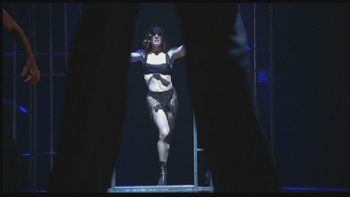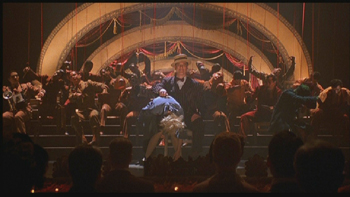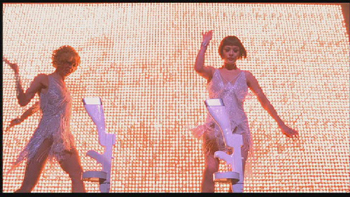 BUY IT AT AMAZON: CLICK HERE!
BUY IT AT AMAZON: CLICK HERE!
STUDIO: Miramax
MSRP: $29.99
RATED: PG-13
RUNNING TIME: 113 Minutes
SPECIAL FEATURES:
• Feature commentary with director and writer
• Deleted musical number "Class"
• "From Stage to Screen" featurette
• Extended musical performances
• "Chita Rivera’s Encore" featurette
• Profiles of director Rob Marshall, designers John Myhre and Colleen Atwood
• "When Liza Minnelli Became Roxie Hart" featurette
• VH1’s Behind the Movie: Chicago
It’s rare
that a film is successful based mostly on its technical merits. Often, the
alchemy of filmmaking — that stuff separate from our primary focus, the actors
— is placed lower in the proverbial mix, designed to be unobtrusive, to carry
the story. When technique is fronted, and story subdued, the film is decried as
having too much style, too little substance. Rob Marshall’s
intense style, and very little substance, and it’s very nearly a complete
success.
The Flick
The story
for
Zellweger and Catherine Zeta-Jones, are thrown in jail with the threat of
hanging if they are found guilty. Enter Billy Flynn, maverick lawyer and master
of spinning the media and spectacle into acquittals for his clients. The two
women compete for Billy’s attention, and for that of the reporters, all of
which flit from one big case to the next. The screenplay, by Bill Condon, plays
up the fear of anonymity, mostly for its potential to render an uncaring guilty
sentence. Essentially,
whores.

"Garrett! The sheriff has the key to the safe on his belt!"
Such a
plot is easily extrapolated by the audience into modern times, where the
Internet offers channels of quick, short-lived fame and the newsmedia have had
both their biases and their gullibility well-documented. As mild social
commentary, then, Chicago takes a similar angle as that of Alan Moore’s From
Hell, which shows the hatching of a meme that rides long and hard over
the twentieth century. Only instead of a fascination with serial killers, the
film explores our media-centric culture’s infatuation with a good story, no
matter the reliability of the data.
Since the
movie is based on the Bob Fosse musical of the same name, it manages to avoid
being as weighty as yours truly; whether or not that’s a good thing is entirely
subjective, but I will note the absence of real depth to the storytelling as
one of the film’s qualities. Contributing to the feeling that it tiptoes around
its own issues is Rob Marshall’s direction.
a feature-film director, and his direction is flat; he treats most of his
spaces like stages, with minimal camera movement and a real lack of visual
focus during dialogue sequences.
His
primary contribution to the film was the concept of restructuring a number of
the song-and-dance numbers so that they seemed to take place inside Roxie
Hart’s (Zellweger) fantasies. This fundamental change really sets of the film
for a number of its more ironic moments, which are its strength. Bill Condon’s
screenplay, though a bit dull in dialogue (the wittiness of the musical numbers
overshadows the workmanlike lines) seizes upon the story opportunities
presented by this change and packs in some wonderful visual and dramatic
dissonance.

Haunted at night by visions of painful sexual positions, Catherine
was forced to turn to Ingmar Bergman for therapy.
Most of
these take place during the lead-up to, and execution of, the musical numbers,
which deserve a paragraph of their own. The plot necessitates that the numbers
get bigger, grander, more spectacular as the running time increases (in
contrast to Moulin Rouge, in which the numbers become more subdued as they
progress toward resolution), and there’s not a dud in the bunch. The original
music is deep, and as full of comic beats as the lyrics are full of
double-entendres. The choreography is out of sight, from sultry cool jazz steps
to the wild "Cell Block Tango." Zeta-Jones deserves high praise for
doing her own steps, as does, to a lesser degree, Zellweger. As the show heads
toward the circus-room atmosphere of the final courtroom scene, the
vaudevillian references pick up and leave the viewer with a dizzying show of
disparate talents.
The
softer bits are built with just as much love, if not such a grand display of
skill. "Mr. Cellophane," John C. Reilly’s subdued lament sticks him
on a stage that seems to be in the middle of teardown, costumed in hobo-clown
garb, singing his tired heart out. The preservation of and service done to
these jazzy songs is a great justice, to fans and newcomers to the musical,
especially since
a good song than character development.
If the
media is the primary focus of the plot, then sex and spectacle are its
complement. The characters, while affected by media attention and misdirection,
are really more concerned with the seedier sides of things. There’s a palpable
desperation to the characters that hover near the poverty line, a sense that
their lives don’t revolve around major events but on getting through the day
without losing the will to live. The songs beat that desperation into a frenzy,
vibrant moments of carnality that give some small motivation to those watching,
and power to those in charge of the song and the dance.

Sometimes making a movie is as easy as setting up a tripod
in your star’s dressing room.
Speaking
of sex, Catherine Zeta-Jones-Douglas the Great turns in a fine, manipulative
performance. Her technical skill both with the singing and dancing is
admirable, and she nails the opportunistic character of Velma Kelly. Richard
Gere does a similarly excellent job, balancing between sympathy and greed and
occasionally dipping over to one side over the other. The thing is that the
performances in
great deal of conviction. This is where Zellweger stumbles, in my opinion. She
doesn’t carry the movie as she ought to, because she doesn’t play her role
straight. She makes her actions big when they don’t need to be, and never quite
slides into the tone of irony.
As I
mentioned before, that irony is what drives the movie. It comes in two flavors:
the visual and the dramatic. The visual ironies crop up during the musical
numbers, particularly during "We Both Reached For The Gun" in which
the words say one thing while the spectacle carries a totally different
meaning. In that example, Gere sings about Roxie’s sob-story while behind them
the reporters dance around on marionette strings, which we eventually see are
being controlled by Gere.
The
dramatic ironies are similar, but more subtle. They occur in dialogue, best
exemplified by the double entendres when a line of dialogue means several
things at once. It’s great when irony is done right, to make the audience feel
clever and to be at once humorous and inspiring, and, for the most part,
As a
celebration of cynicism, this film is a blast. The plot is thin, but not so
thin that you can see right through it. It dispenses with character development
in favor of driving home the more abstract concepts on which it is based, and
suffers a little for it. The trifecta of actors is given a big of a lame leg
with Zelwegger, though Zeta-Jones and Gere carry the film well enough with two
points of contact. Going meta for a moment, it makes me really happy that it
did as well as it did, seeing as how it’s a subversive piece of culture
philosophy, and doesn’t have a satisfying ending. I’m not convinced it deserved
all the honors that were heaped on it, given that only half of it functions
smoothly, but, in a weird twist of math, that half is enough to give it a
solid:
8.2 out of 10

Don’t let the forced perspective fool you: she’s as tall as you,
and her ribs are larger than your biceps.
The Look
1.86:1
widescreen. Would you believe me if I told you the quality of the visuals for
this release were surprisingly awful? I’m usually trustworthy. The transfer is
generally clean, but there are numerous instances of ill-fitting film stock,
shots that are full of a heavier grain than necessary. At first, I was
wondering if my poor critic’s mind had abandoned me and I wasn’t grasping a
major artistic decision, but when one half of a two-shot is grainy and the
other is clear, I have difficulty accepting it as visual metaphor. It’s
especially bad because the clear scenes are exceptionally clear.
There is
also a lot of black in this film — darkened stages, smoky nightclubs, dank
cells — and the black tone is off, coming in noticeably purple.
6 out of 10

What a time to run out of euphemisms.
The Noise
Yeah, you
could listen to your Dolby digital 5.1 track; or you could please the Lord your
God and switch over to the 5.1 DTS track. Thrill at hearing every last
molasses-dripped note that comes from Taye Diggs’ piano! Exult in the throaty
brass that supports Queen Latifah’s sexy solo! Savor Catherine Zeta-Jones tonal
growl in "Cell Block Tango!" The music is a great survey course in
different jazz styles, and totally deserved this track. For fans of musicals,
it would have been worth the price of the disc just to get the DTS on the musical
numbers. During dialogue sequences, the track is obviously thinner, but the
ambient sound effects in prison and on the
clarity.
The Dolby
track isn’t bad, for those of you without access to a DTS setup. Its musical numbers
are a bit bass-heavy for my tastes, which makes the overall mix feel just a
touch muddy.
9.5 out of 10
The Goodies
There are
a decent number of bonuses spread across two discs. The first disc has the
feature, with its wonderful audio track, as well as a feature commentary with
the writer and director, a deleted musical number, and a mini-documentary about
the history of
The
commentary has a good give-and-take between Rob Marshall and Bill Condon, and
both are articulate in their musings on the structure of the film. During
musical segments, they tend to drop out a little and enjoy their own work. They
also do quite a bit of consideration on using the technique of making the
musical numbers occur in Roxie’s imagination. And, Rob Marshall, being a
choreographer by trade, covers a lot of the nimble editing that links the
choreography. It’s an informative commentary all the way along.
"Class,"
featuring Queen Latifah and Catherine Zeta-Jones, is the deleted musical number.
You can watch it with or without audio commentary by Rob Marshall and Bill
Condon. Their commentary revolves around why the sequence was cut, which is
because it jarred with the "musical-in-Roxie’s-head" concept. The
song is great, though it lacks the DTS track that makes the other music stand
out, but the harmony of the duet, though simple, is nailed by the leads.
The
featurette, "From Stage to Screen: The History of
into three parts: the original stage play, the long, oft-aborted process of
adapting the show into a film, and the eventual success of the film. The play
was one that
properly, and its twisted history makes for an entertaining bit of education.
Plus it’s nice to hear from Jerry Orbach, who played Billy Flynn in the
original Broadway run.

When Chester’s voice gave out, John C. Reilly as Emo Clown was brought on as lead singer of Linkin Park. He promptly fainted.
The
second disc has a number of smaller features. There are extended musical
performances, a bit of a feature on castmember Chita Rivera, a profile
(classified as an "intimate look") of Rob Marshall, a featurette
about Liza Minnelli’s stint as Roxie, interviews with the film’s production and
costume designers, and a VH1 special.
The
extended musical performances include footage from the film, segments on the
recording of specific songs, and selected rehearsal footage. It’s nice to have
a bit of background on the development of the songs, as well as having some of
the grander tunes isolated for individual viewing.
The
"Chita Rivera Encore" does a little retrospective on the actress’
experience with this film version (she played Velma Kelly in the original
cast). It’s a two-way love note: from
Marshall to
The
"Intimate Look at Director Rob Marshall" is a little unnecessary, and
perhaps even unwelcome.
through predictable humility, and it can grate on a person’s nerves. The tone
of the feature is defensive, trying to sell
director’s chair, which is off-putting. The man only has a debut under him;
we’ll get a better picture of his talent after Memoirs of a Geisha opens
wide.
"When
Liza Minnelli Became Roxie Hart" is just an anecdote from the film’s
executive producers regarding Minnelli’s charitable offer to replace the
original Roxie Hart when that actress came down with a nasty, feather-induced
infection. It’s good trivia for fans of the show.

Like all tools, the guns eventually rose against their human masters.
In small human conclaves, women took to spanking guns
in effigy to raise the morale of their fellows.
The two
profiles of production designer John Myhre and costume designer Colleen Atwood
are brief, but a sweet bit of spotlight for artists that are often relegated to
the end credits. The costuming and design are full of great detail, and the two
designers are well-worthy of this attention.
And,
finally, VH1’s feature is predictable pre-release marketing fluff, capitalizing
on the easy stories surrounding the production: Rob Marshall’s brief breakdown,
the relative lack of training of the two female leads, and the spectacle of the
musical numbers. There’s no info contained in this feature that haven’t been
covered elsewhere on these discs.
All in
all, a good number of bonuses with a respectable worthwhile-to-worthless ratio.
7.5 out of 10
The Artwork
Very
similar to the theatrical posters, but with a bit of new razzle and dazzle. The
foiled background is a nice touch, and the positioning of the actors is
memorable. The looks and angles of the two female leads are sexy, but also
carry with them the implication that they are submissive to the showbiz
philosophy his character represents. I betcha didn’t know there was light
bondage on the cover of your favorite movie.
8.5 out of 10
Keeping
in mind the visual quality, which knocks off a bit of the score:
Overall: 8.5 out of 10